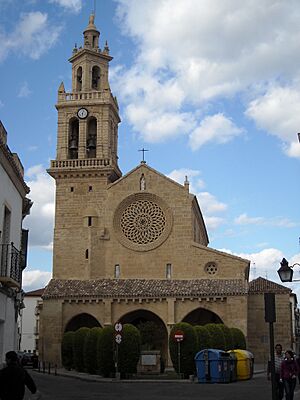San Lorenzo, Córdoba facts for kids
San Lorenzo is a beautiful church located in Córdoba, Andalusia, a city in southern Spain. It stands in the historic heart of Córdoba. This church was one of twelve important religious buildings ordered by King Ferdinand III of Castile after his army took control of the city in the early 1200s.
Contents
A Look at History
The San Lorenzo church was built on a very old site. Before it was a church, there was an Islamic mosque there. Even before the mosque, there was an even older church from the Visigothic period. This means the spot has been a special place for worship for a very long time!
Building the Church
Construction of the church began around 1244 and finished by 1300. It shows a mix of two different building styles: Romanesque and Gothic architecture. This blend is called a "transitional style." It has a common design for churches in the Andalusia region from that time. The church has a rectangular shape with a main central area (called a nave) and two side sections (called aisles).
Special Features of the Church
San Lorenzo has many interesting parts that show its long history and different building styles.
The Entrance and Bell Tower
The church has a covered entrance area called a portico. This was added in the 1500s. It has three arches that are slightly pointed, a style known as "ogival."
The tall bell tower of the church used to be an Islamic minaret. A minaret is a tower from which a call to prayer is made. It was changed into a Renaissance-style bell tower by an architect named Hernán Ruiz the Younger.
The Rose Window
Above the portico, you can see a large, round window called a rose window. This window is a mix of Gothic and Mudéjar styles. The Mudéjar style combines Christian and Islamic art and architecture. It's a beautiful example of how different cultures influenced the building.
Inside the Church
The main part of the church, the nave, has a special ceiling. It's called a "coffered ceiling" and has sunken panels, like squares or other shapes. This ceiling also shows a mix of Mudéjar and Renaissance styles.
At the very end of the church, there's a curved section called the apse. In the apse, you can see paintings from the 1300s. These paintings show scenes from the life of Jesus. They were inspired by the Italian Gothic art style. You can also spot figures of saints and prophets with golden halos. The decoration also looks like Byzantine azulejos, which are colorful glazed tiles. The main altar, built in the 1600s, also shows scenes from the life of Saint Lawrence, who the church is named after.
See also
 In Spanish: Iglesia de San Lorenzo (Córdoba) para niños
In Spanish: Iglesia de San Lorenzo (Córdoba) para niños


